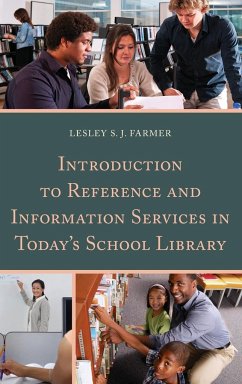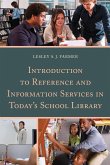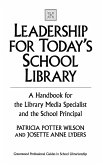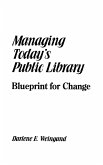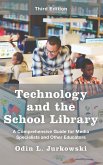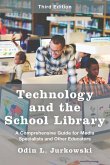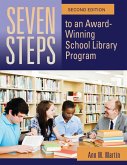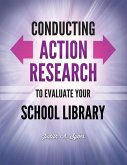Lesley S. J. Farmer
Introduction to Reference and Information Services in Today's School Library
Lesley S. J. Farmer
Introduction to Reference and Information Services in Today's School Library
- Gebundenes Buch
- Merkliste
- Auf die Merkliste
- Bewerten Bewerten
- Teilen
- Produkt teilen
- Produkterinnerung
- Produkterinnerung
In Introduction to Reference and Information Services in Today's School Library, one of America's premier school library educators covers the A-Z of both reference and information services for today's library. Lesley Farmer discusses everything from teaching students how to use sources to both in-person and virtual reference service.
Andere Kunden interessierten sich auch für
![Introduction to Reference and Information Services in Today's School Library Introduction to Reference and Information Services in Today's School Library]() Lesley S. J. FarmerIntroduction to Reference and Information Services in Today's School Library93,99 €
Lesley S. J. FarmerIntroduction to Reference and Information Services in Today's School Library93,99 €![Leadership for Today's School Library Leadership for Today's School Library]() Patricia WilsonLeadership for Today's School Library70,99 €
Patricia WilsonLeadership for Today's School Library70,99 €![Managing Today's Public Library Managing Today's Public Library]() Darlene WeingandManaging Today's Public Library55,99 €
Darlene WeingandManaging Today's Public Library55,99 €![Technology and the School Library Technology and the School Library]() Odin L. JurkowskiTechnology and the School Library121,99 €
Odin L. JurkowskiTechnology and the School Library121,99 €![Technology and the School Library Technology and the School Library]() Odin L. JurkowskiTechnology and the School Library67,99 €
Odin L. JurkowskiTechnology and the School Library67,99 €![Seven Steps to an Award-Winning School Library Program Seven Steps to an Award-Winning School Library Program]() Ann MartinSeven Steps to an Award-Winning School Library Program45,99 €
Ann MartinSeven Steps to an Award-Winning School Library Program45,99 €![Conducting Action Research to Evaluate Your School Library Conducting Action Research to Evaluate Your School Library]() Judith A. SykesConducting Action Research to Evaluate Your School Library44,99 €
Judith A. SykesConducting Action Research to Evaluate Your School Library44,99 €-
-
-
In Introduction to Reference and Information Services in Today's School Library, one of America's premier school library educators covers the A-Z of both reference and information services for today's library. Lesley Farmer discusses everything from teaching students how to use sources to both in-person and virtual reference service.
Produktdetails
- Produktdetails
- Verlag: Rowman & Littlefield Publishers
- Seitenzahl: 196
- Erscheinungstermin: 27. März 2014
- Englisch
- Abmessung: 235mm x 157mm x 15mm
- Gewicht: 443g
- ISBN-13: 9780810893092
- ISBN-10: 0810893096
- Artikelnr.: 39876051
- Herstellerkennzeichnung
- Libri GmbH
- Europaallee 1
- 36244 Bad Hersfeld
- gpsr@libri.de
- Verlag: Rowman & Littlefield Publishers
- Seitenzahl: 196
- Erscheinungstermin: 27. März 2014
- Englisch
- Abmessung: 235mm x 157mm x 15mm
- Gewicht: 443g
- ISBN-13: 9780810893092
- ISBN-10: 0810893096
- Artikelnr.: 39876051
- Herstellerkennzeichnung
- Libri GmbH
- Europaallee 1
- 36244 Bad Hersfeld
- gpsr@libri.de
Lesley S. J. Farmer coordinates the Library Media Teacher program at California State University Long Beach, where she also serves as a reference librarian for the university's library. She is the author and co-author of numerous books, including Technology Infused Instruction for the Educational Community (Scarecrow, 2004) and Information Literacy Assessment in K-12 Settings (Scarecrow, 2007).
Chapter 1: What Does Reference and Information Service in Today's School
Look Like? Today's World Sidebar: Inventing Reference and Information
Services Defining Terms Reference and Information Services within the
School Library Program Sidebar: Gathering RIS Baseline Data References
Chapter 2: Determing Your Community's Needs Environmental Scan User
Populations Developmental Issues Special Populations Adult Needs SWOT
Analysis Conclusions References Chapter 3: Assessing Information Behaviors
Interacting with Information The Added Task of Information Seeking
Intermediaries Youth's Information Behaviors Children's Information
Behaviors Teens' Information Behaviors Ethical Issues in Teens' Information
Behavior General RIS Implications Theories of Information Behavior
Optimizing Information Seeking Strategies A Question of Behavior Quality A
Note about Information Architecture Searching Print Resources Searching the
World Wide Web Searching Database Aggregators Considering Other Literacies
Manipulating Information Sidebar: Constructing Questions Assessing
Information Behaviors References Chapter 4: Developing Resource Collections
What is a Reference Resource? Profile of the Typical Reference Resource
Types of Reference Sources Encyclopedias Dictionaries Almanacs and
Yearbooks Atlases Handbooks and Manuals Biographical Sources Guides to
Other Sources Selecting Reference Sources Generic Reference Selection
Criteria Selecting Electronic Reference Sources Factors in Choosing Formats
Sidebar: Humans as Reference Sources Selection Processes Selection Steps
Selection Tools Reference Sources Life Cycle Core Reference Collection
Suggestions Elementary Middle School High School Professional Resource
Sharing References Chapter 5: Providing Physical Access Cataloging and
Organization Digital Reference Resource Access The Big Picture about
Library Portals Sidebar: The Merits of Browsing References Chapter 6:
Conducting Reference Interactions Standards Librarian Standards Reference
Service Standards Youth-Specific Standards The Physical and Virtual Context
of Reference Interaction Interacting with Populations with Special Needs
Purposeful RIS Interaction Types of Reference Questions Reader's Advisory
Sidebar: What is the Real Question? RIS Interactions in Online Environments
Online Visual Interaction Online Interactive Skills Collaboration Basics of
Collaboration Partnerships Collaborative Activities Sidebar: Student
iSquads References Chapter 7: Providing Reference and Information Services
Instruction Information Literacy and Learning Standards Instruction to
Improve Information Behaviors Side Bar: Mapping the Curriculum
Instructional Design Side Bar: Research Presentation Rubric Resources
Instructional Delivery Time Issues Space Issues Staffing Instructional
Method Student Participation Side Bar: Learning Activity Collaborative
Planning Checklist Dealing with Major Research Projects Side Bar: Sample
Social Justice Learning Activity References Chapter 8: Curating Reference
and Information Services What is Curation? Packaging Information
Purpose-Specific Information Packaging Format-Specific Information
Packaging Dynamic Packaging of Information Branding References Chapter 9:
Dealing with Legal and Ethical Issues Legal Issues RIS Ethics and School
Librarians Library Position Statements Dealing with Ethics Sidebar: Equity
in the Library/ Media Center Research Ethics Teaching Legal and Ethical
Information Behavior Ethics Isn't Easy References Chapter 10: Managing
Reference and Information Services Facilities for RIS RIS Technology Issues
RIS Staffing Issues RIS Policies and Procedures RIS Finances School Library
Public Relations and Marketing Strategic Planning and Assessment
Comparative Assessment Sidebar: RIS Planning Guide Planning for the Future
References Index About the Author
Look Like? Today's World Sidebar: Inventing Reference and Information
Services Defining Terms Reference and Information Services within the
School Library Program Sidebar: Gathering RIS Baseline Data References
Chapter 2: Determing Your Community's Needs Environmental Scan User
Populations Developmental Issues Special Populations Adult Needs SWOT
Analysis Conclusions References Chapter 3: Assessing Information Behaviors
Interacting with Information The Added Task of Information Seeking
Intermediaries Youth's Information Behaviors Children's Information
Behaviors Teens' Information Behaviors Ethical Issues in Teens' Information
Behavior General RIS Implications Theories of Information Behavior
Optimizing Information Seeking Strategies A Question of Behavior Quality A
Note about Information Architecture Searching Print Resources Searching the
World Wide Web Searching Database Aggregators Considering Other Literacies
Manipulating Information Sidebar: Constructing Questions Assessing
Information Behaviors References Chapter 4: Developing Resource Collections
What is a Reference Resource? Profile of the Typical Reference Resource
Types of Reference Sources Encyclopedias Dictionaries Almanacs and
Yearbooks Atlases Handbooks and Manuals Biographical Sources Guides to
Other Sources Selecting Reference Sources Generic Reference Selection
Criteria Selecting Electronic Reference Sources Factors in Choosing Formats
Sidebar: Humans as Reference Sources Selection Processes Selection Steps
Selection Tools Reference Sources Life Cycle Core Reference Collection
Suggestions Elementary Middle School High School Professional Resource
Sharing References Chapter 5: Providing Physical Access Cataloging and
Organization Digital Reference Resource Access The Big Picture about
Library Portals Sidebar: The Merits of Browsing References Chapter 6:
Conducting Reference Interactions Standards Librarian Standards Reference
Service Standards Youth-Specific Standards The Physical and Virtual Context
of Reference Interaction Interacting with Populations with Special Needs
Purposeful RIS Interaction Types of Reference Questions Reader's Advisory
Sidebar: What is the Real Question? RIS Interactions in Online Environments
Online Visual Interaction Online Interactive Skills Collaboration Basics of
Collaboration Partnerships Collaborative Activities Sidebar: Student
iSquads References Chapter 7: Providing Reference and Information Services
Instruction Information Literacy and Learning Standards Instruction to
Improve Information Behaviors Side Bar: Mapping the Curriculum
Instructional Design Side Bar: Research Presentation Rubric Resources
Instructional Delivery Time Issues Space Issues Staffing Instructional
Method Student Participation Side Bar: Learning Activity Collaborative
Planning Checklist Dealing with Major Research Projects Side Bar: Sample
Social Justice Learning Activity References Chapter 8: Curating Reference
and Information Services What is Curation? Packaging Information
Purpose-Specific Information Packaging Format-Specific Information
Packaging Dynamic Packaging of Information Branding References Chapter 9:
Dealing with Legal and Ethical Issues Legal Issues RIS Ethics and School
Librarians Library Position Statements Dealing with Ethics Sidebar: Equity
in the Library/ Media Center Research Ethics Teaching Legal and Ethical
Information Behavior Ethics Isn't Easy References Chapter 10: Managing
Reference and Information Services Facilities for RIS RIS Technology Issues
RIS Staffing Issues RIS Policies and Procedures RIS Finances School Library
Public Relations and Marketing Strategic Planning and Assessment
Comparative Assessment Sidebar: RIS Planning Guide Planning for the Future
References Index About the Author
Chapter 1: What Does Reference and Information Service in Today's School
Look Like? Today's World Sidebar: Inventing Reference and Information
Services Defining Terms Reference and Information Services within the
School Library Program Sidebar: Gathering RIS Baseline Data References
Chapter 2: Determing Your Community's Needs Environmental Scan User
Populations Developmental Issues Special Populations Adult Needs SWOT
Analysis Conclusions References Chapter 3: Assessing Information Behaviors
Interacting with Information The Added Task of Information Seeking
Intermediaries Youth's Information Behaviors Children's Information
Behaviors Teens' Information Behaviors Ethical Issues in Teens' Information
Behavior General RIS Implications Theories of Information Behavior
Optimizing Information Seeking Strategies A Question of Behavior Quality A
Note about Information Architecture Searching Print Resources Searching the
World Wide Web Searching Database Aggregators Considering Other Literacies
Manipulating Information Sidebar: Constructing Questions Assessing
Information Behaviors References Chapter 4: Developing Resource Collections
What is a Reference Resource? Profile of the Typical Reference Resource
Types of Reference Sources Encyclopedias Dictionaries Almanacs and
Yearbooks Atlases Handbooks and Manuals Biographical Sources Guides to
Other Sources Selecting Reference Sources Generic Reference Selection
Criteria Selecting Electronic Reference Sources Factors in Choosing Formats
Sidebar: Humans as Reference Sources Selection Processes Selection Steps
Selection Tools Reference Sources Life Cycle Core Reference Collection
Suggestions Elementary Middle School High School Professional Resource
Sharing References Chapter 5: Providing Physical Access Cataloging and
Organization Digital Reference Resource Access The Big Picture about
Library Portals Sidebar: The Merits of Browsing References Chapter 6:
Conducting Reference Interactions Standards Librarian Standards Reference
Service Standards Youth-Specific Standards The Physical and Virtual Context
of Reference Interaction Interacting with Populations with Special Needs
Purposeful RIS Interaction Types of Reference Questions Reader's Advisory
Sidebar: What is the Real Question? RIS Interactions in Online Environments
Online Visual Interaction Online Interactive Skills Collaboration Basics of
Collaboration Partnerships Collaborative Activities Sidebar: Student
iSquads References Chapter 7: Providing Reference and Information Services
Instruction Information Literacy and Learning Standards Instruction to
Improve Information Behaviors Side Bar: Mapping the Curriculum
Instructional Design Side Bar: Research Presentation Rubric Resources
Instructional Delivery Time Issues Space Issues Staffing Instructional
Method Student Participation Side Bar: Learning Activity Collaborative
Planning Checklist Dealing with Major Research Projects Side Bar: Sample
Social Justice Learning Activity References Chapter 8: Curating Reference
and Information Services What is Curation? Packaging Information
Purpose-Specific Information Packaging Format-Specific Information
Packaging Dynamic Packaging of Information Branding References Chapter 9:
Dealing with Legal and Ethical Issues Legal Issues RIS Ethics and School
Librarians Library Position Statements Dealing with Ethics Sidebar: Equity
in the Library/ Media Center Research Ethics Teaching Legal and Ethical
Information Behavior Ethics Isn't Easy References Chapter 10: Managing
Reference and Information Services Facilities for RIS RIS Technology Issues
RIS Staffing Issues RIS Policies and Procedures RIS Finances School Library
Public Relations and Marketing Strategic Planning and Assessment
Comparative Assessment Sidebar: RIS Planning Guide Planning for the Future
References Index About the Author
Look Like? Today's World Sidebar: Inventing Reference and Information
Services Defining Terms Reference and Information Services within the
School Library Program Sidebar: Gathering RIS Baseline Data References
Chapter 2: Determing Your Community's Needs Environmental Scan User
Populations Developmental Issues Special Populations Adult Needs SWOT
Analysis Conclusions References Chapter 3: Assessing Information Behaviors
Interacting with Information The Added Task of Information Seeking
Intermediaries Youth's Information Behaviors Children's Information
Behaviors Teens' Information Behaviors Ethical Issues in Teens' Information
Behavior General RIS Implications Theories of Information Behavior
Optimizing Information Seeking Strategies A Question of Behavior Quality A
Note about Information Architecture Searching Print Resources Searching the
World Wide Web Searching Database Aggregators Considering Other Literacies
Manipulating Information Sidebar: Constructing Questions Assessing
Information Behaviors References Chapter 4: Developing Resource Collections
What is a Reference Resource? Profile of the Typical Reference Resource
Types of Reference Sources Encyclopedias Dictionaries Almanacs and
Yearbooks Atlases Handbooks and Manuals Biographical Sources Guides to
Other Sources Selecting Reference Sources Generic Reference Selection
Criteria Selecting Electronic Reference Sources Factors in Choosing Formats
Sidebar: Humans as Reference Sources Selection Processes Selection Steps
Selection Tools Reference Sources Life Cycle Core Reference Collection
Suggestions Elementary Middle School High School Professional Resource
Sharing References Chapter 5: Providing Physical Access Cataloging and
Organization Digital Reference Resource Access The Big Picture about
Library Portals Sidebar: The Merits of Browsing References Chapter 6:
Conducting Reference Interactions Standards Librarian Standards Reference
Service Standards Youth-Specific Standards The Physical and Virtual Context
of Reference Interaction Interacting with Populations with Special Needs
Purposeful RIS Interaction Types of Reference Questions Reader's Advisory
Sidebar: What is the Real Question? RIS Interactions in Online Environments
Online Visual Interaction Online Interactive Skills Collaboration Basics of
Collaboration Partnerships Collaborative Activities Sidebar: Student
iSquads References Chapter 7: Providing Reference and Information Services
Instruction Information Literacy and Learning Standards Instruction to
Improve Information Behaviors Side Bar: Mapping the Curriculum
Instructional Design Side Bar: Research Presentation Rubric Resources
Instructional Delivery Time Issues Space Issues Staffing Instructional
Method Student Participation Side Bar: Learning Activity Collaborative
Planning Checklist Dealing with Major Research Projects Side Bar: Sample
Social Justice Learning Activity References Chapter 8: Curating Reference
and Information Services What is Curation? Packaging Information
Purpose-Specific Information Packaging Format-Specific Information
Packaging Dynamic Packaging of Information Branding References Chapter 9:
Dealing with Legal and Ethical Issues Legal Issues RIS Ethics and School
Librarians Library Position Statements Dealing with Ethics Sidebar: Equity
in the Library/ Media Center Research Ethics Teaching Legal and Ethical
Information Behavior Ethics Isn't Easy References Chapter 10: Managing
Reference and Information Services Facilities for RIS RIS Technology Issues
RIS Staffing Issues RIS Policies and Procedures RIS Finances School Library
Public Relations and Marketing Strategic Planning and Assessment
Comparative Assessment Sidebar: RIS Planning Guide Planning for the Future
References Index About the Author

